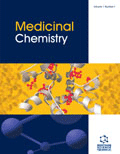Abstract
Background: Fibroblast growth factor (FGF) receptors (FGFRs) play a key role in tumor growth and angiogenesis. The present report describes our search for an extracellularly binding FGFR inhibitor using a combined molecular modeling and de novo design strategy.
Methods: Based upon crystal structures of the receptor with its native ligand and knowledge of inhibiting peptides, we have developed a computational protocol that predicts the putative binding of a molecule to the extracellular domains of the receptor. This protocol, or scoring function, was used in combination with the de novo synthesis program 'SYNOPSIS' to generate high scoring and synthetically accessible compounds.
Results: Eight compounds belonging to 3 separate chemical classes were synthesized. One of these compounds, alofanib (RPT835), was found to be an effective inhibitor of the FGF/FGFR2 pathway. The preclinical in vitro data support an allosteric inhibition mechanism of RPT835. RPT835 potently inhibited growth of KATO III gastric cancer cells expressing FGFR2, with GI50 value of 10 nmol/L.
Conclusion: These results provide strong rationale for the evaluation of compound in advanced cancers.
Keywords: Fibroblast growth factor receptor 2, allosteric inhibitor, alofanib, RPT835.
Medicinal Chemistry
Title:Molecular Modeling, de novo Design and Synthesis of a Novel, Extracellular Binding Fibroblast Growth Factor Receptor 2 Inhibitor Alofanib (RPT835)
Volume: 12 Issue: 4
Author(s): Ilya Tsimafeyeu, Frits Daeyaert, Jean-Baptiste Joos, Koen V. Aken, John Ludes-Meyers, Mikhail Byakhov and Sergei Tjulandin
Affiliation:
Keywords: Fibroblast growth factor receptor 2, allosteric inhibitor, alofanib, RPT835.
Abstract: Background: Fibroblast growth factor (FGF) receptors (FGFRs) play a key role in tumor growth and angiogenesis. The present report describes our search for an extracellularly binding FGFR inhibitor using a combined molecular modeling and de novo design strategy.
Methods: Based upon crystal structures of the receptor with its native ligand and knowledge of inhibiting peptides, we have developed a computational protocol that predicts the putative binding of a molecule to the extracellular domains of the receptor. This protocol, or scoring function, was used in combination with the de novo synthesis program 'SYNOPSIS' to generate high scoring and synthetically accessible compounds.
Results: Eight compounds belonging to 3 separate chemical classes were synthesized. One of these compounds, alofanib (RPT835), was found to be an effective inhibitor of the FGF/FGFR2 pathway. The preclinical in vitro data support an allosteric inhibition mechanism of RPT835. RPT835 potently inhibited growth of KATO III gastric cancer cells expressing FGFR2, with GI50 value of 10 nmol/L.
Conclusion: These results provide strong rationale for the evaluation of compound in advanced cancers.
Export Options
About this article
Cite this article as:
Tsimafeyeu Ilya, Daeyaert Frits, Joos Jean-Baptiste, Aken V. Koen, Ludes-Meyers John, Byakhov Mikhail and Tjulandin Sergei, Molecular Modeling, de novo Design and Synthesis of a Novel, Extracellular Binding Fibroblast Growth Factor Receptor 2 Inhibitor Alofanib (RPT835), Medicinal Chemistry 2016; 12 (4) . https://dx.doi.org/10.2174/1573406412666160106154726
| DOI https://dx.doi.org/10.2174/1573406412666160106154726 |
Print ISSN 1573-4064 |
| Publisher Name Bentham Science Publisher |
Online ISSN 1875-6638 |
 99
99 6
6 1
1 2
2
- Author Guidelines
- Graphical Abstracts
- Fabricating and Stating False Information
- Research Misconduct
- Post Publication Discussions and Corrections
- Publishing Ethics and Rectitude
- Increase Visibility of Your Article
- Archiving Policies
- Peer Review Workflow
- Order Your Article Before Print
- Promote Your Article
- Manuscript Transfer Facility
- Editorial Policies
- Allegations from Whistleblowers
Related Articles
-
Synthetic Lethality to Overcome Cancer Drug Resistance
Current Medicinal Chemistry Bacterial Translocation, Microcirculation Injury and Sepsis
Endocrine, Metabolic & Immune Disorders - Drug Targets Tissue Fatty Acid Profile is Differently Modulated from Olive Oil and Omega-3 Polyunsaturated Fatty Acids in ApcMin/+ Mice
Endocrine, Metabolic & Immune Disorders - Drug Targets The Detection of Adverse Events in Randomized Clinical Trials: Can we Really Say New Medicines are Safe?
Current Drug Safety Emerging Therapeutic Potential of Whey Proteins and Peptides
Current Pharmaceutical Design The Impact of Probiotic on Gut Health
Current Drug Metabolism Synthesis and Antiproliferative Activity of New Polyoxo 2-Benzyl-2,3- dihydrobenzofurans and Their Related Compounds
Letters in Drug Design & Discovery The Engaged Role of Tumor Microenvironment in Cancer Metabolism: Focusing on Cancer-Associated Fibroblast and Exosome Mediators
Anti-Cancer Agents in Medicinal Chemistry Inhibitory Effects of Water Caltrop Pericarps on the Growth of Human Gastric Cancer Cells In Vitro
Current Pharmaceutical Design Target Therapies in Pancreatic Carcinoma
Current Medicinal Chemistry Azole Antimycotics - A Highway to New Drugs or a Dead End?
Current Medicinal Chemistry Cytokines and Chemokines as Regulators of Angiogenesis in Health and Disease
Current Pharmaceutical Design LHRH Targeted Chonderosomes of Mitomycin C in Breast Cancer: An In Vitro/ In Vivo Study
Anti-Cancer Agents in Medicinal Chemistry Marine Actinomycetes-derived Natural Products
Current Topics in Medicinal Chemistry Implications of the Dominant Role of Transporters in Drug Uptake by Cells
Current Topics in Medicinal Chemistry Effects of Eugenol on the Central Nervous System: Its Possible Application to Treatment of Alzheimers Disease, Depression, and Parkinsons Disease
Current Bioactive Compounds An Optimised Radiolabel Procedure to Prepare 99mTc-Colloidal Rhenium Sulphide to Improve Radiochemical Purity
Current Radiopharmaceuticals Nuclear Imaging of Prostate Cancer with Gastrin-Releasing-Peptide- Receptor Targeted Radiopharmaceuticals
Current Pharmaceutical Design Role of Dietary Fiber and Short-Chain Fatty Acids in the Colon
Current Pharmaceutical Design Stability Studies on Piroxicam Encapsulated Niosomes
Current Drug Delivery


























